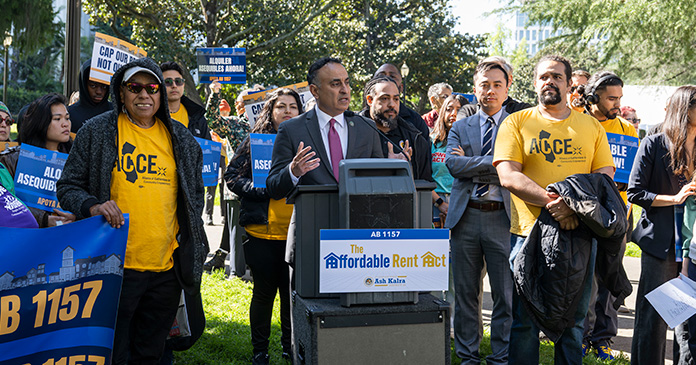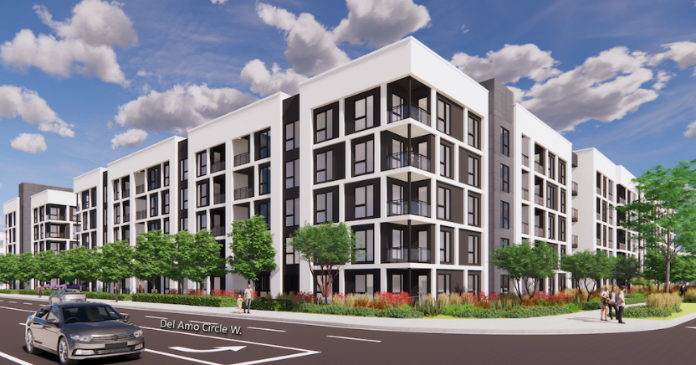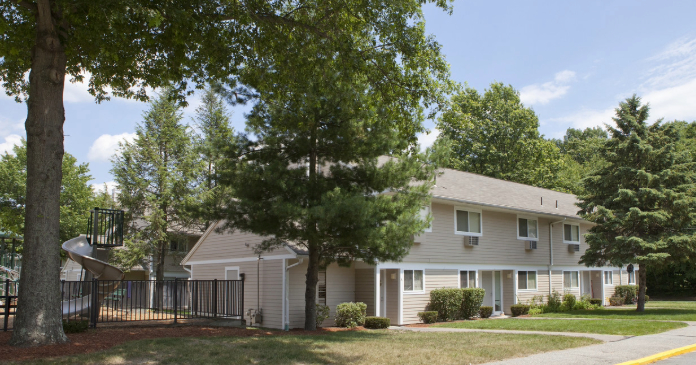The Employment Situation Report from the Bureau of Labor Statistics stated that overall employment growth rose in September from the gain initially reported for last month. In addition, last month’s employment level was revised higher in this month’s report, so the gain is relative to a higher base than in last month’s report. The employment levels in all 4 of the multifamily-related job categories we track rose from the preliminary levels reported last month.
Revisions add to reported employment level
The BLS reported that total seasonally adjusted non-farm employment increased by 254,000 jobs in September, based on their survey of business establishments. Last month’s gain of 142,000 jobs was revised up to 159,000 jobs while July’s gain, reported as 118,000 jobs last month, was revised upward to 144,000 jobs in this month’s report.
Given the revisions, the actual reported employment level from the business survey is up by 326,000 jobs from the preliminary level reported last month at 159,105,000 jobs.
The employment levels for recent months as given in the last three employment reports are illustrated in the first chart, below, based on the survey of business establishments. Generally, each report includes data for the current month and revised data for the previous two months. The chart shows that revisions in last month’s report were to the downside while revisions in this month’s report were to the upside.
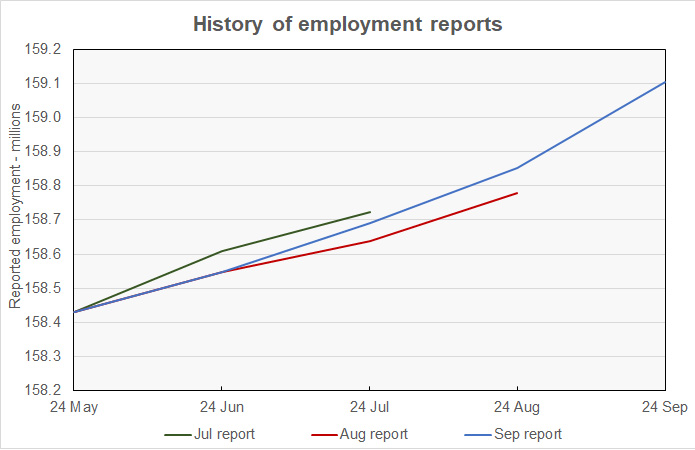
The BLS household survey reported that the US unemployment rate fell 0.1 percentage point to 4.1 percent. The household survey found that the number of employed persons rose by 430,000 from that reported for last month to 161,864,000. The number of unemployed persons fell by 281,000 to 6,834,000.
The household survey also found that the number of people in the civilian labor force rose by 150,000 in September while the adult civilian population rose by 224,000. The labor force participation rate was effectively unchanged, remaining at 62.69 percent. It had been at 63.33 percent before the pandemic. Recovering that 0.62 percent decline in the labor force participation rate would bring 1.67 million more people into the workforce.
Tracking multifamily employment
The BLS reported more detailed employment information on four job categories of interest to the multifamily industry. These are employment as residential construction workers, as specialty trades within residential construction, as residential property managers and as lessors of residential buildings. As usual, some of the data is reported with a month delay, so the latest figures for the latter two categories are for the month of August.
Residential construction employment rises
The next chart shows the history of the levels of employment since 2015 in the two construction jobs categories we track.
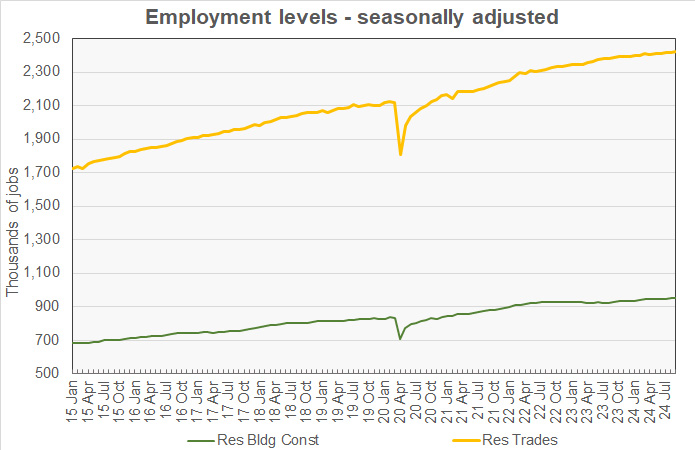
Employment in residential building construction in September, usually with general contractors, was reported to be up by 2,000 jobs. However, the prior month’s employment level was revised lower by 1,400 jobs so reported employment in this category is only 600 jobs higher than the preliminary value reported last month. Employment in this category is now 951,500 jobs, up 2.5 percent year-over-year.
Employment in residential building trades, i.e. plumbers, electricians, etc., in September was reported to be up 5,800 jobs from last month’s level. In addition, the August jobs figure was revised higher by 2,400 jobs so employment in this category is 8,200 jobs higher than the level reported last month. Employment in residential building trades is now 2,424,700 jobs, up 1.6 percent year-over-year.
Total September employment growth in these two categories of residential construction jobs combined is +0.23 percent from the revised level of the month before and +1.8 percent year-over-year. Employment is up 0.26 percent from the preliminary level for August contained in last month’s report.
Multifamily operations jobs increase
The next chart shows the history of the levels of employment since 2015 in the two property management jobs categories we track.
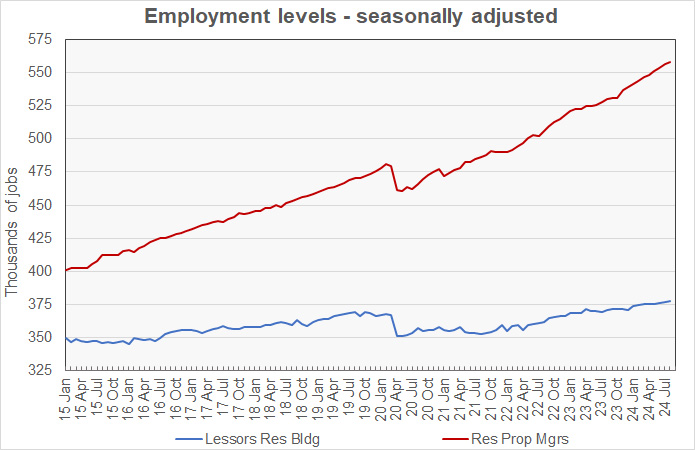
Employment for residential property managers in August was reported to be up by 1,300 jobs, from its revised (+400 jobs) level for July to 557,800 jobs. Employment for residential property managers is up 5.3 percent year-over-year.
Employment for lessors of residential buildings in August was reported to be up 700 jobs from the revised (+400 jobs) level for July at 377,600 jobs. Employment in this category is up 1.7 percent year-over-year.
Total employment growth in these two categories of apartment operations jobs combined was reported to be +0.21 percent, compared to the revised level for last month and +3.8 percent year-over-year. Employment is up 0.26 percent from the preliminary level for July contained in last month’s report.
Illustrating the trends
The final chart, below, presents the employment data in a different format. It normalizes the employment levels in each of the four jobs categories to a reading of 100 for January 2015. It also provides trend lines for the growth in each of the categories of employment based on the period from January 2015 through February 2020.
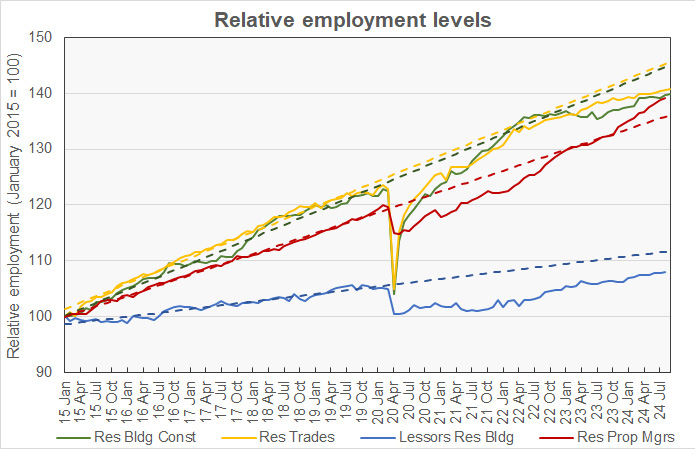
Residential building construction employment is now 3.6 percent below trend. Residential trades employment is now 3.3 percent below trend. Residential property managers employment is 2.4 percent above trend and lessors of residential buildings employment is now 3.2 percent below trend.
The numbers given in the Employment Situation report are seasonally adjusted and are subject to revision. It is common for small adjustments to be made in subsequent reports, particularly to the data for the most recent month. The current Employment Situation report can be found here.







